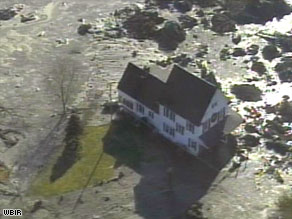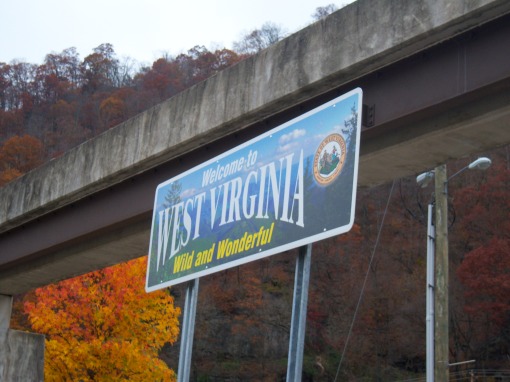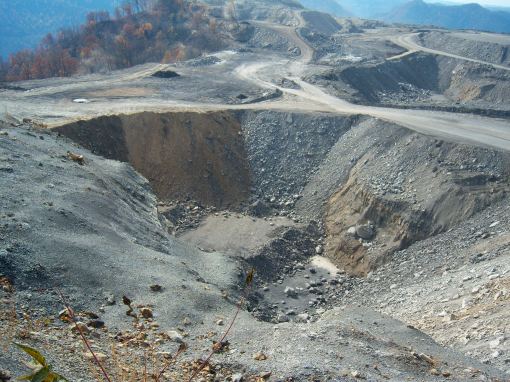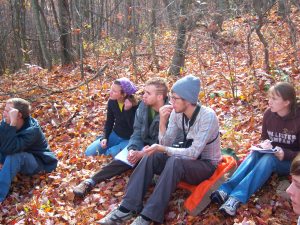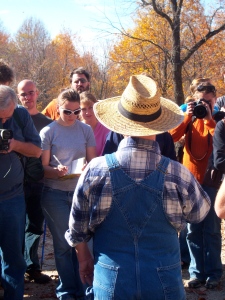The Mountain Tops are Crying: West Virginia Coal
Gene Stoltzfus peaceprobe blog: http://peaceprobe.wordpress.com
My Lord, what a mourning,
My Lord, what a mourning,
My Lord, what a mourning,
When the stars begin to fall.
You’ll hear the trumpet sound
To wake the nations underground,
Looking to my God’s right hand,
When the stars begin to fall.
– The Books of American Negro Spirituals,1925-26 by James Weldon Johnson and J. Rosamond Johnson
I slowed down for the curves and watched for signs to Hawk’s Nest Park as I approached Ansted. The State Park was established near Gauley Mountain on the New River where local people told me between 470 and 700 mostly African American miners died while working for Union Carbide from 1927 to 1933. The workers contracted silicosis in the mines while tunnelling through a mountain to build a hydro electric plant, one of the worst industrial disasters in the history of the Americas.
As I approached the mountain top on Highway 60 in my Ford Ranger I found myself humming the old Negro spiritual that I sang as a child, “My Lord, What a Mourning when the stars begin to fall” except in my version mourning had become morning. It was dark as I approached Ansted. The mountains were only remote shadows as snow began to fall. In the version of the song of long forgotten slaves I hum the lines that had been morphed as they travelled voice to ear over the decades..
“We’ll cry for rocks and rocks and mountains when the stars begin to fall,
Rocks and mountains they’ll not save you when the stars begin to fall.”
I searched for an hour along unlit one lane roads for Allen Johnson who would host me at a Christians for the Mountains facility. Modest homes that once housed mine workers were plentiful. As I searched for the guest house I listened to public radio for reports on the Copenhagen meeting. Finally, I gave up searching turned off the radio and called Allen. He met me at the Ansted Pharmacy and led me to the rented guest house beside a century old Baptist church. The old spiritual was still echoing from my unconscious.
As I approached my lodging I could see the outline of Gauley Mountain in the distance and Allen told me that just over the edge I would see mountain top coal removal but that would have to await the daylight. Allen had warned me that 500 mountain tops have been dynamited layer by layer in West Virginia, Kentucky, Virginia and Tennessee – Appalachia – to reach the seams of coal. The coal is carried by train, barge and truck to power plants to generate electricity and to factories where steel is fashioned.
Rocks from the blasting have buried a thousand miles of streams and destroyed 12 percent of West Virginia forests forever. The Appalachian mountains that once reached heights equalling the great Himalayas of South Asia rose 300 million years ago when coal was formed from trees, swamps and other vegetation. Part of the energy for the light that illuminates my screen as I write may come from this coal.
The price for coal is rising. Surface mining permits the only efficient access to thin seams of coal formed 50 million years before dinosaurs, that traditional underground mining can not reach. With the use of large machinery and explosives two and a half times as much coal per worker can be extracted as in underground mines.
My own life has a connection to Appalachia coal. Sixty years ago when my Northeast Ohio family used coal for heating, 125,000 people worked in the mines. Today that number has fallen to 15,000 because of mechanization. Already then, Appalachian miners with their children fled homes due to joblessness, health problems and poverty. Their special accent was a matter of curiosity in my second and third grade class. Later when I lived in Chicago the north side Uptown neighbourhood was populated by people seeking refuge from the coal fields, many suffering from black lung disease. Today Ansted is more than 60% retired people. Few residents now work in the coal mines. However, coal dust, sounds of dynamite, coal trucks, and plans for more mountain levelling threaten the town’s new vision, to transform itself into a tourist center.
On the day after I arrived people were loath to travel the mountain roads due to snow so I stopped by the Redeemer Episcopal Church. I cautiously entered the annex of the 120 year old church where ladies were holding a fund raiser. My caution was formed by a belief that an Episcopal Church like this one would have been founded to serve the owners of the mines. No sooner did I park myself in front of one of the lady’s cookie tables than I was asked, “Are you here to work to stop Mountain Top Removal?” in a tone that definitely suggested that I would be much more welcome if I would answer, “Yes”.
I asked the ladies selling cookies for more information about the mountains. Over hot cider and cookies a woman from the kitchen informed me that their church goes out to the mountains regularly where their priest leads participants from surrounding churches in BLESSINGS for the mountains. She inferred that these events were not popular with the coal companies. “I hope you are here the next time we do a Blessing.” said another woman.
Allen took me to visit his friend Larry Gibson at Keyford mountain twenty miles west of Ansted as the crow flies. “Thanks for finally coming to see me” said Larry who met Allen and me with a big hug and a hot cup of coffee. The use of the word “finally” in his jovial greeting was unmistakably firm. I knew it was meant for me. “We need your support.”
Larry’s family line traces its roots in Keyford mountain back 200 years and the evidence lies silently in the nearby cemeteries at least the graves that have not yet been dynamited away. Along the winding road to his mountain top memorial hide way I see the remains of another mountain that has been blasted away, a valley blocked with land fill, huge coal trucks and shards of chimneys from long burned out homes that once housed 10,000 people who lived off mining. Larry cares for the pristine property of his ancestors as a sign of resistance to dynamite, and power shovels. Five times a year on key holidays he invites hundreds of people to festivals like of celebration and remembrance of Keyford mountain.
But not all of Larry’s guests are friendly. Drunken thugs show up to frighten visitors away much like company hired goons once tried to break union organizing in the coal fields. He describes 15 years of struggle, the offers of millions to buy him out, intimidation, arrests and speaking tours before leading us out over his 59 acre mountain top spread, a living trophy to persistence and survival. We pass several cabins where distant relatives come for retreat. He points to bullet holes, a long closed store and finally we pass Hell’s Gate, the property boundary beyond which we begin to view the empty disappeared mountain top beyond.
Below I can see layers of coal and massive power shovels loading coal trucks for delivery to a processing site and later shipment for power generation. In another direction bulldozers slice off rock that has been loosened with blasts of dynamite for disposal in the valley below. A hardy but bland grass has been planted on the mountainside next to his property where mining was terminated. There are no trees, shrubs, mice or deer, just grass. I see the town of Dorothy in a hazy valley beyond, named a century ago in honour of the wife of a mining company owner.
Visiting with Larry Gibson was good preparation for the rally at West Virginia’s state capital, Charleston, called to stop mountain top removal at still another site, Coal River Mountain. The Monday, December 7 protest brought together hundreds from West Virginia and neighbouring states. Everyone gathered in front of the West Virginia state Environmental Protection Agency which has rubber stamped so many company mining initiatives. Cordoned off about 100 feet behind the rally and adjacent to the agency building were 150 counter protesters, some hired by mining companies from the village of Dorothy. Greeting many of the speakers as they rose to challenge the crowd were blood curdling blasts from the horns of coal trucks programmed by the coal industry to cruise just a block away but loud enough to be heard maybe as far away as Copenhagen,. Rally speakers creatively co-opted the horns with long chants that transformed their irritating noise barrage into future friends, “Hoooooonk if you love the mountains.”
As I departed a voice inside told me to go to wake the nations. The descendants of coal miners who live in the hollows and valleys believe that Appalachia can be saved. The industry claims that rallies like the one in Charleston are the result of outsider manipulation by tree huggers. In spite of the charges I found an expanding conviction in West Virginia that the dust of coal pollution and lakes of slime, artificial polluted reservoirs created from crushing and cleaning coal, will be stopped. When people work together to change things they create a culture for transformation.
Several days later as I pulled out of Ansted I flipped on the radio to check developments in Copenhagen. The sombre reports of disunity among the nations reminded me to be realistic but thankful for the people, some diplomats, demonstrators and lobbyists who by their actions remembered the coal fields and disappearing mountain tops. The snow had ended and the fog had lifted. I could see the mountains and knew there was hard work ahead beyond the mourning or was it morning. It’s a new year. It’s a new decade.

Gene Stoltzfus with the Dustbusters
Note: Gene Stotzfus has 45 years experience as an activist and advocate for peace, justice, and joy. He is the founder and director (retired) of Christian Peacemaker Teams. His visit to West Virginia inspired us. —Allen Johnson
 Bishop Wills
Bishop Wills


